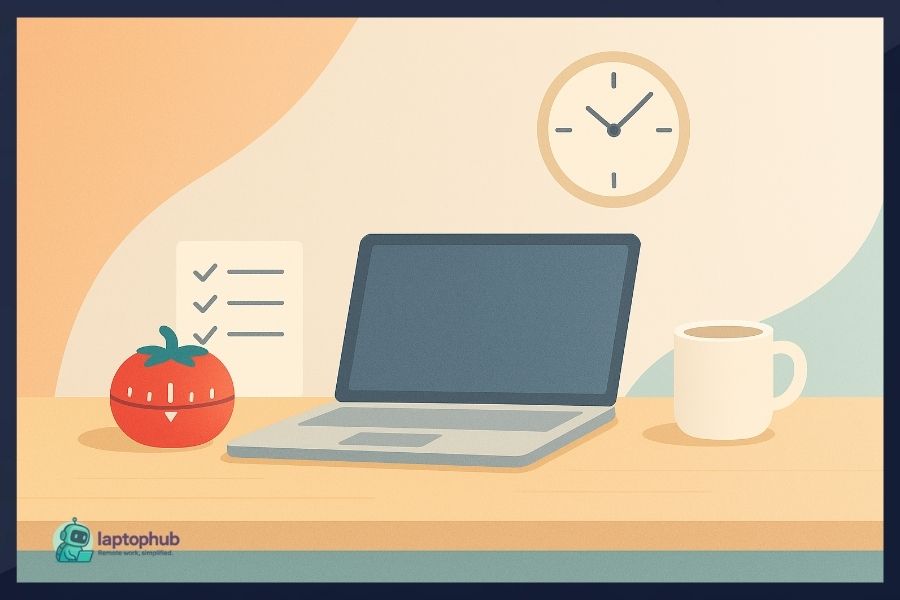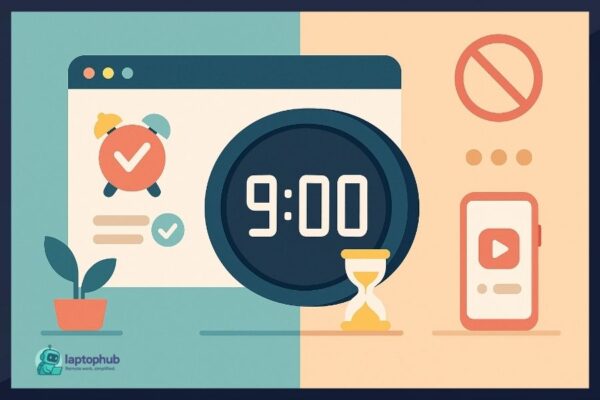Working from home may seem like a dream—until your to-do list grows while your focus fades. Remote workers everywhere are battling constant distractions, blurred work-life lines, and the creeping exhaustion of always being “on.” The Pomodoro Technique, a deceptively simple time management method, could be the solution you’ve been overlooking. With just a timer and a bit of discipline, you can reclaim your productivity, sharpen your focus, and finally create a work rhythm that actually works.
💡Key takeaways:
- The Pomodoro Technique helps remote workers manage time effectively by breaking work into focused intervals with regular breaks.
- It addresses common remote work challenges such as distractions, burnout, and lack of structure.
- Implementing Pomodoro with the right tools and workspace setup boosts productivity and work-life balance.
- With flexibility and consistency, the technique can be adapted to fit different remote work styles and needs.
What Is the Pomodoro Technique?
Created by Francesco Cirillo in the late 1980s, the Pomodoro Technique is a time management method that uses a timer to break work into intervals, traditionally 25 minutes long, separated by short breaks. Each interval is called a “Pomodoro.”
Basic Structure:
- Work for 25 minutes (1 Pomodoro)
- Take a 5-minute break
- After 4 Pomodoros, take a longer break (15-30 minutes)
This simple system helps you stay focused, prevent burnout, and get more done in less time.
Why Remote Workers Struggle with Focus
Working from home has its perks, but it’s easy to fall into traps:
- Distractions: From social media to household chores
- Isolation: Lack of structure and accountability
- Overworking: Blurred lines between work and rest
- Lack of time tracking: It’s hard to know where the day goes without clear time blocks
These issues often lead to procrastination, decision fatigue, and mental exhaustion. The Pomodoro Technique offers a simple, science-backed framework to impose structure and protect your mental energy.
Benefits of the Pomodoro Technique for Remote Workers
1. Improved Focus
With a timer ticking, you’re less likely to check your phone or wander off mentally. It creates urgency and encourages deep work sessions, cutting through distractions.
2. Prevents Burnout
Short breaks give your brain a chance to rest and recharge, making it easier to sustain focus throughout the day without feeling overwhelmed.
3. Better Time Awareness
You start to understand how long tasks actually take, which leads to better planning, improved project estimates, and realistic scheduling.
4. Increased Accountability
Even without a manager over your shoulder, the Pomodoro Technique creates a personal accountability system. Each Pomodoro becomes a commitment to focused work.
5. Reduces Procrastination
Starting a task is easier when you know it’s only for 25 minutes. This “just start” mindset lowers the mental barrier to beginning work, especially on big or boring tasks.
6. Supports Work-Life Balance
By encouraging regular breaks and structured work sessions, the Pomodoro Technique helps draw a clearer line between work time and personal time.
How to Use the Pomodoro Technique Remotely
Step 1: Choose a Task
Pick one task to work on during each Pomodoro. Avoid multitasking. If the task is large, break it into smaller parts. If it’s too small, group it with other similar tasks.
Step 2: Set a Timer for 25 Minutes
Use a physical timer, a phone app, or a browser extension. Popular Pomodoro apps include:
- Pomofocus
- Toggl Track
- Forest (great for reducing phone usage)
- TomatoTimer (minimalist and web-based)
Step 3: Work on the Task Without Interruptions
No social media, no emails, no Slack messages. Just work. If something distracting comes to mind, jot it down quickly and return to the task.
Step 4: Take a 5-Minute Break
Get up. Stretch. Grab water. Avoid screens if you can. These mini breaks help reset your focus and reduce physical fatigue.
Step 5: Repeat
After four Pomodoros, take a longer 15-30 minute break. Use this time to disconnect—take a walk, meditate, or eat lunch away from your desk.
Optimizing Your Home Office for Pomodoro
To make the most of this method, set up a distraction-free environment:
- Dedicated workspace: Even a small, designated area signals your brain it’s time to work
- Noise-canceling headphones: Block out ambient noise and help signal focus time
- Clear desk policy: Keep only essential tools in front of you to reduce visual clutter
- Visual timer or app: Helps you stay aware of the session without switching tabs or using your phone
- Do Not Disturb signals: Set boundaries with family or housemates using a sign, light indicator, or shared schedule
Common Pitfalls (And How to Avoid Them)
- Too many interruptions: Let others know when you’re in a Pomodoro session. Use a visible cue or update your Slack status.
- Being too rigid: If you’re in deep flow, it’s okay to extend your session. Flexibility helps preserve momentum.
- Over-scheduling Pomodoros: Not every task needs this structure. Use it where it brings value—creative work, focus-heavy projects, or admin batching.
- Skipping breaks: Breaks are part of the system. Skipping them defeats the purpose and can lead to fatigue.
Real-World Example: A Day Using Pomodoro as a Remote Worker
Here’s how a typical day might look for a remote content marketer:
9:00 AM – 9:25 AM: Pomodoro #1 – Write blog content
9:30 AM – 9:55 AM: Pomodoro #2 – Continue writing
10:00 AM – 10:25 AM: Pomodoro #3 – Edit and proofread
10:30 AM – 10:55 AM: Pomodoro #4 – Schedule posts and review SEO checklist
11:00 AM – 11:30 AM: Long break – Walk outside, coffee, relax
1:00 PM – 1:25 PM: Pomodoro #5 – Answer emails
1:30 PM – 1:55 PM: Pomodoro #6 – Client updates & feedback review
2:00 PM – 2:25 PM: Pomodoro #7 – Draft social media posts
2:30 PM – 2:55 PM: Pomodoro #8 – Admin tasks
3:00 PM – 3:30 PM: Long break – snack, light stretching
This structured rhythm helps break the day into manageable pieces and boosts productivity while minimizing fatigue.
Advanced Tips for Power Users
If you’re already familiar with the Pomodoro Technique, try these tweaks:
- Adjust interval lengths: Some people prefer 50/10 instead of 25/5—find your rhythm
- Track your sessions: Use a spreadsheet or app to log Pomodoros and analyze where your time goes
- Theme your days: Use Pomodoros to focus on certain types of tasks (e.g., writing in the morning, admin in the afternoon)
- Pair it with other methods: Combine Pomodoro with time-blocking, Eisenhower Matrix, or daily goal setting for even more structure
Is the Pomodoro Technique Right for You?
It works best for:
- Writers, developers, marketers, and others doing focused or creative work
- People who struggle with procrastination, focus, or working long hours without results
- Remote workers looking to introduce clear boundaries and work structure
It might not work as well for:
- Jobs requiring frequent, unpredictable communication
- Roles with constant context switching or team collaboration
Pomodoro Technique for Remote Workers FAQs
Is the Pomodoro Technique really effective for remote workers?
Yes. It introduces structure and focus into a typically unstructured work-from-home environment, improving productivity and reducing burnout.
Can I adjust the Pomodoro timer if 25 minutes doesn’t work for me?
Absolutely. Many people adapt the method to suit their energy levels—try 50/10 or 90/20 if that fits better.
What types of tasks work best with the Pomodoro Technique?
Deep work like writing, coding, designing, and content planning is ideal. It’s also useful for repetitive tasks like emails or data entry.
What if I get interrupted during a Pomodoro session?
Pause the session and deal with the interruption only if it’s urgent. Otherwise, jot it down and revisit it during a break.
Are there apps that support the Pomodoro Technique?
Yes—popular ones include Pomofocus, Forest, and Toggl Track, which help manage intervals and track progress.
Final Thoughts
The Pomodoro Technique isn’t about rigid rules—it’s about creating flow and structure in your workday. For remote workers trying to reclaim their focus and work-life balance, it offers a simple, flexible system that can transform productivity without burning out.
Start small. Set one timer. Get through one Pomodoro. Then build from there. Over time, this method can turn scattered days into focused, energizing work sessions—and help you actually feel done when the day ends.





